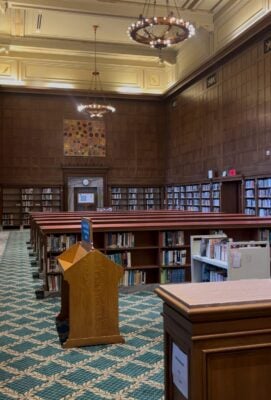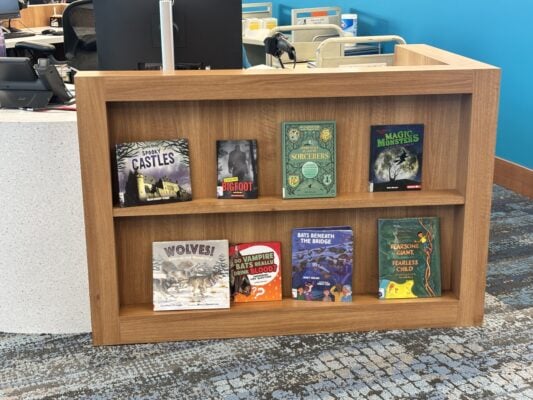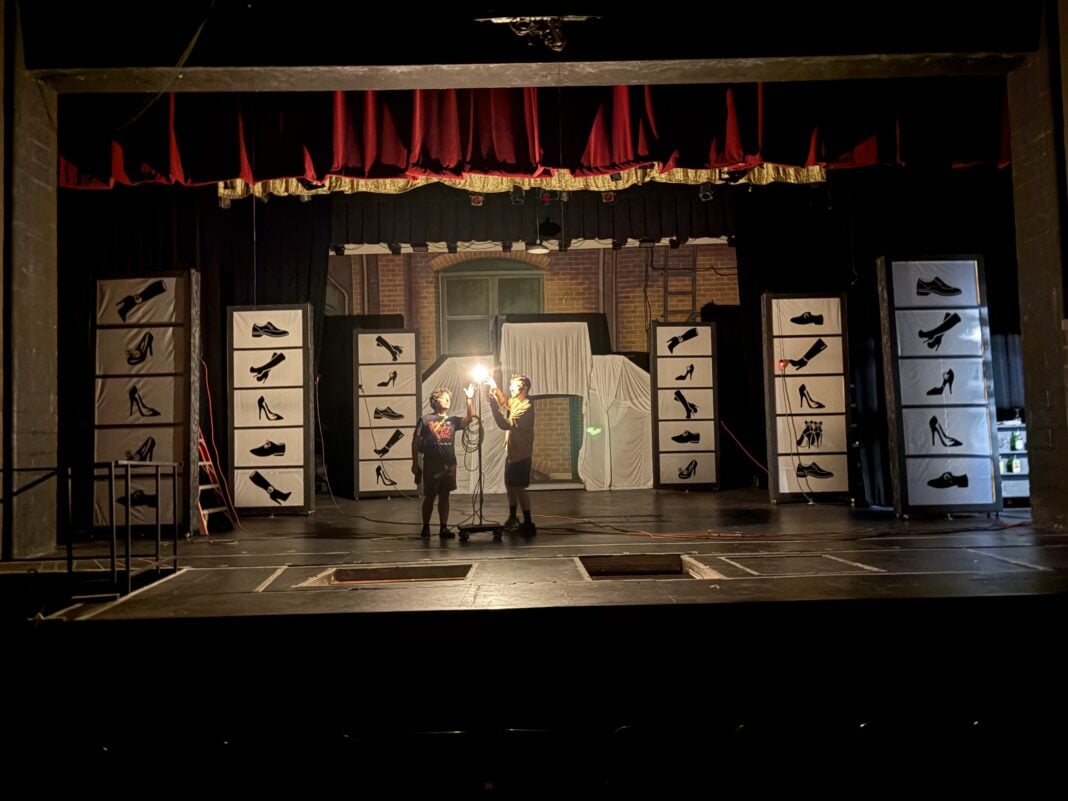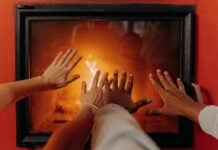Have you ever heard the Indianapolis Public Library has ghosts?
The Central Library Branch, to be exact, and they’re not the only ones. Other historical buildings around the city — such as the Indiana Repertory Theatre, the Indianapolis Athletic Club and the Hedback Theatre — have all reported claims of spirits lingering after hours.
“From having been the former Director of Central Library before I took this position, we’ve had several different paranormal investigations over the years, and while a ghost never reached out and tapped anybody on the shoulder during those investigations, their various meters and sensing instruments did record activity,” said Mike Williams, senior manager of archives, resources and delivery for IndyPL. “So, if one were to believe in ghosts, Central is almost certainly haunted.”

Central Library is more than 100 years old, and the property it’s built on looked significantly different at the turn of the 19th century, Williams said. There were additional cross streets, schools, houses, businesses, and Indigenous people lived there for hundreds of years before white settlers came — so the idea that some spirits might linger isn’t so far-fetched.
READ MORE: Trick-or-treat with care: Halloween safety tips to avoid a different kind of fright
Williams said there have been reports of overnight security guards seeing chairs pushed out or pushed in and doors opening and closing in places like the East Reading Room.
“Ghosts, the Paranormal folks tell me, are very place-based for some reason or other,” Williams said. “So, some of these folks likely were here before Central Library.”
The Hedback Theatre, home of Footlite Musicals, is also an older historic building, having recently celebrated its 100th anniversary. Rumors of ghosts in the theatre have circulated among various cast and crew members for the last several years.
The most popular sighting is of “Dorthy,” the friendly spirit of a woman often seen in the second and third floor apartments of the theatre. The story goes that “Dorthy” stayed back at the theatre to work during the blizzard of 1977 and got snowed in. She decided to spend her time dressed up, putting on shows all by herself. When she eventually passed away, her spirit reportedly returned to the theatre.
Located on 19th and Alabama Street, the theatre is located at what would’ve been the edge of the prisoner of war encampment during the Civil War, said Leslie Lee, former president of Footlite Musicals. Over the years, Lee told the Recorder dozens of guests have seen shadows of soldiers walking past them in the theatre.
“We have a ghost light that goes out on stage every night,” Lee said. “I like to think of it so that the ghosts can put on a show while no one is around and do it in light.”
During the pandemic, a photo of the ghost light was included in the program as a way to welcome guests back to the theatre and “wish the spirits of the past be gone,” Lee added.
Beyond onsite haunts, IndyPL also hosts a collection of books and other reading materials detailing all the haunted happenings across the Hoosier state. Halloween is IndyPL’s second biggest holiday collection and circulates widely across the entire library system, said Montoya Barker, special collections librarian.
Special collection and adult titles in circulation include “Skiles Test and the House of Blue Lights” by K.J. Miclot, “Ghost Hunters Guide to Indianapolis” by Lorri Sankowsky and Keri Young; and “More Irvington Haunts” by Alan E. Hunter.
Even the newly renovated children’s section has a display for age-appropriate books on Bigfoot sightings, vampire bats, wolves, monsters and “Spooky Castles.”

“Little kids love Halloween stories,” Barker said. “We bring them out of storage and put them out just after back-to-school, and they just go and go and go. So, it is a very popular thing for parents and caregivers to read with little ones.”
A common theme in a majority of the titles about Indianapolis and Irvington’s haunted spots is that they are based on somebody’s experience, Williams said. The library carries a few books written by Al Hunter, who continues to lead ghost tours in Irvington.
“While people on the ghost tour may or may not have experienced something, and in some cases they have, tales continue to be told,” Williams added. “Irvington was the first stop outside of Indianapolis, because Irvington was a suburb, so Lincoln’s funeral train was on the tracks and made a visit to Irvington on certain nights. People still swear they hear that train.”
The Encyclopedia of Indianapolis, which is free to access, regardless of whether guests have a library card, features an entire database of true crime stories, ghost tales and Indiana-related folklore, said Jyoti Verderame, assistant managing editor of the Encyclopedia of Indianapolis.
Crown Hill Cemetery, Hannah House, Cold Spring Murder Case, Robert “Sammy Terry” Carter, Grave Robbing and the House of Blue Lights are popular entries this time of year, Verderame said.
“Everybody loves true crime, and along with true crime, there are ghost stories, right? Because whenever you have a dead person, then you’ve got the ghost following it,” Verderame said. “At the Encyclopedia, we find that our true crime entries drive a lot of our traffic.”
However, the newest urban legend entries include the IRT, which is said to be haunted by the ghost of Tom Hass, who was struck and while on a run outside the theatre in 1991; and the Indianapolis Athletic Club, which caught on fire in 1992 and has received reports of a ghost trying to wake people up.
Grave robbing
Downtown, at the intersection of Delaware and Court Street, a parking lot holds some potentially spooky history surrounding early grave robbing. In the 1870s, a four-story building known as the Parker Block was constructed for the Indiana Medical College, according to Danita Davis, Administrative Assistant to the Vice Chancellor for Student Affairs and Enrollment Management at Indiana University.
“I found this terribly interesting and yet terribly flippant 1923 Star article about bones being found underneath the building and the possibility of them being related to the medical school,” Davis said in an email to the Recorder. “Early medical schools appeared to have a hard time finding dissection subjects, which led to grave robbing in Indianapolis at this time.”
An 1874 article in the Indianapolis News reported that the City Sexton urged officials and police to take action to prevent grave robbing at Greenlawn Cemetery. An Indianapolis Star article dated Feb. 3, 1923, reports Barney Dowe of Bryan Construction Company “discovered bones about two feet beneath the surface of the ground,” while excavating and “considered” a link to the medical college that previously occupied the building.
Davis said this could be a “plausible answer to the question of where wayward dissection study cadavers ended up” after having been robbed from their graves. Today, Parker Block is home to a parking lot and a mural created by Roland Hobart in 1973.
Mourning rites
At the Indiana State Museum, Meredith McGovern and Kisha Tandy said a few of the death-related artifacts boast some surprisingly comforting stories about mourning and funeral rituals.
In 2007, the Indiana Funeral Directors Association donated 130 funerary objects, including caskets, embalming bottles, a cosmetic case and clothing, McGovern said. Among the caskets are two designed for children, one with a viewing pane, the other covered in white silk cloth. Tandy, the curator of social history at the Indiana State Museum, said the caskets contrast the young and the old, a reminder that death is “part of all of our lives.”
“I know that’s a little odd, but there’s something very peaceful about both of these,” Tandy added. “Yes, we’ve lost our children, but we’re sending them away in this kind of very respectful manner.”

McGovern, Indiana State Museum’s arts and culture collections manager, said some of her favorite artifacts in the collection are more sentimental than spooky — including a crown of feathers, found in the pillow of Margaret Denson in 1922, and a death mask of a woman believed to have passed sometime between 1820-1855 named Martha Meriweather.
The crown of feathers originates in Appalachian folklore, McGovern said. It was tradition to cut open the pillow of a loved one after their death to check the goose feather stuffing. If the feathers were found tightly curled up in the shape of a spiral crown, it signified that their deceased loved one had received their “heavenly crown.”
“I think it speaks more to the people who are left behind after someone passes. It’s like something like this brings them comfort, you know?” McGovern said. “If someone’s on their deathbed and sick, they’re maybe rolling around and moving about, and their head is smashing the pillow. … So maybe that explains why this phenomenon might actually happen.”
However, it’s the sentiment that it provides for those grieving that matters, McGovern added. Similarly, a death mask, which would have been constructed fairly quickly after a loved one died and displayed in the home, was meant to provide the grieving family a lasting visual memento.
Death masks were common practice when funeral and burial rites were still taken care of in the home and by family members — and before photography became widely accessible, McGovern said.
“I think there is something comforting to just talking about these practices together and acknowledging that we do this,” McGovern said. “It doesn’t have to be taboo, it doesn’t have to be scary, it doesn’t have to be unsettling.”
So, whether you’re in the mood for a scary story this fall, going ghost hunting or simply interested in learning more about the unusual artifacts related to Indiana’s rich history, the Indiana State Museum, Indianapolis Public Library and Encyclopedia of Indianapolis have something for everyone.
For more information, visit indianamuseum.org, indypl.org or indyencyclopedia.org.
Contact Arts & Culture Reporter Chloe McGowan at 317-762-7848. Follow her on X @chloe_mcgowanxx.
Chloe McGowan is the Arts & Culture Reporter for the Indianapolis Recorder Newspaper. Originally from Columbus, OH, Chloe has a bachelor's in journalism from The Ohio State University. She is a former IndyStar Pulliam Fellow, and has previously worked for Indy Maven, The Lantern, and CityScene Media Group. In her free time, Chloe enjoys live theatre, reading, baking and keeping her plants alive.





